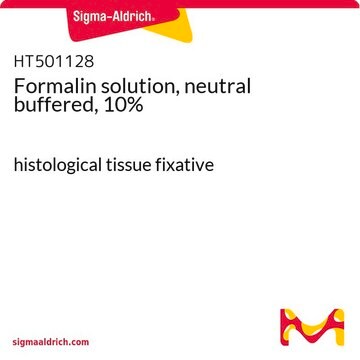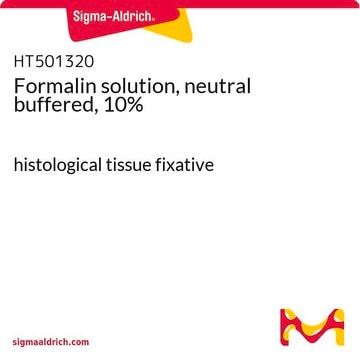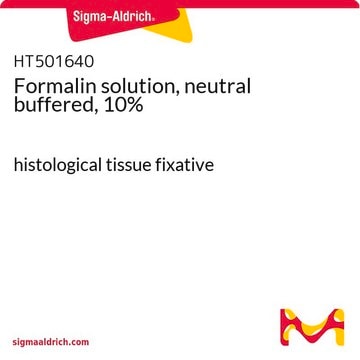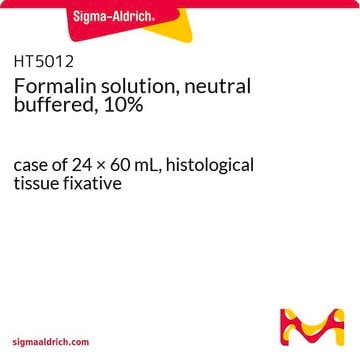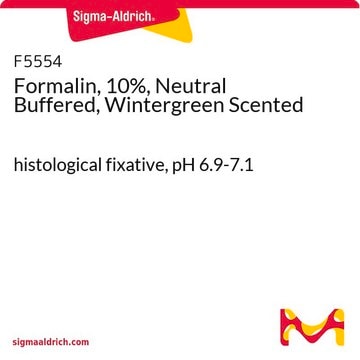The HT5011 solutions are advertised as 10% Neutral Buffered Formalin. The formaldehyde content, however, is expected to be in the range of 3.7% to roughly 4.0%. This can be rather confusing because the terms formaldehyde and formalin are often used interchangeably by some. For many histology laboratories, formaldehyde is used to describe formaldehyde content. Some laboratories do consider the terms interchangeable. Formalin is used to describe a dilution from the 37% to 40% stock bottle of the saturated solution. If the 37% to 40% solution is diluted 1 to 10, this is the origin of the term 10% formalin. But the formaldehyde content is still just 3.7% to 4.0%.
If a simple 2% solution of HT501 is desired, then simply dilute 1 part of HT501 with 4 parts of water. This would result in a formaldehyde content ranging from 0.74% to 0.8%. If you dilute with water, there is a chance the expiration dating could be affected. A better way to dilute 10% formalin would be to create a salt solution used for the original product. To prepare a suitable diluent for dilution, combine 4 grams of sodium phosphate monobasic and 6.5 grams of sodium phosphate, dibasic (anhydrous) in 1 liter of water. The water can be diluted in either distilled or deionized water. If 1 liter of diluent is not required, simply scale down in a proportional amount the amount of chemicals and water used. If the salts are used for dilution, it would probably be best to prepare a 2% solution and use it immediately. If a 2% formaldehyde solution is required, simply dilute the stock HT501 one to one with either water or the salt solution mentioned above. If using water, the same recommendation for immediate use is appropriate.
Wichtige Dokumente
HT5011
Formalinlösung, neutral gepuffert, 10 %
case of 48 × 15 mL, histological tissue fixative
Synonym(e):
Formaldehyd, Methanal
About This Item
Empfohlene Produkte
Verpackung
case of 48 × 15 mL
Konzentration
10% formalin (approx. 4% formaldehyde)
Farbe
colorless
pH-Wert
6.90-7.10
Dichte
1.080 g/cm3
Anwendung(en)
hematology
histology
Lagertemp.
room temp
SMILES String
[O-]#[C+H2]
InChI
1S/CH2O/c1-2/h1H2
InChIKey
WSFSSNUMVMOOMR-UHFFFAOYSA-N
Suchen Sie nach ähnlichen Produkten? Aufrufen Leitfaden zum Produktvergleich
Allgemeine Beschreibung
Anwendung
Verpackung
Physikalische Form
Lagerung und Haltbarkeit
Ähnliches Produkt
Signalwort
Danger
H-Sätze
Gefahreneinstufungen
Acute Tox. 4 Inhalation - Acute Tox. 4 Oral - Carc. 1B - Muta. 2 - Skin Sens. 1
Lagerklassenschlüssel
6.1C - Combustible acute toxic Cat.3 / toxic compounds or compounds which causing chronic effects
WGK
WGK 3
Flammpunkt (°F)
185.0 °F
Flammpunkt (°C)
85 °C
Persönliche Schutzausrüstung
Faceshields, Gloves, Goggles, type ABEK (EN14387) respirator filter
Hier finden Sie alle aktuellen Versionen:
Besitzen Sie dieses Produkt bereits?
In der Dokumentenbibliothek finden Sie die Dokumentation zu den Produkten, die Sie kürzlich erworben haben.
Kunden haben sich ebenfalls angesehen
-
How can a 10% buffered formalin solution be diluted to a 2% solution? Is it necessary to dilute it with buffered solution or can deionized water be used instead?
1 answer-
Helpful?
-
-
Is product HT5011 an IVD product? Is it 100% phosphate buffered?
1 answer-
HT5011 is not a product approved for IVD use. While the product was originally introduced as suitable for IVD use, the IVD status was changed to Research Use Only. The product currently carries a label for Research Use Only and is formulated with formaldehyde, water, and phosphate buffers.
However, there is a product that is approved for IVD use, which is available in package sizes of 700 mL, 5 L, and 10 L, with the product number 100496.
Helpful?
-
Active Filters
Unser Team von Wissenschaftlern verfügt über Erfahrung in allen Forschungsbereichen einschließlich Life Science, Materialwissenschaften, chemischer Synthese, Chromatographie, Analytik und vielen mehr..
Setzen Sie sich mit dem technischen Dienst in Verbindung.